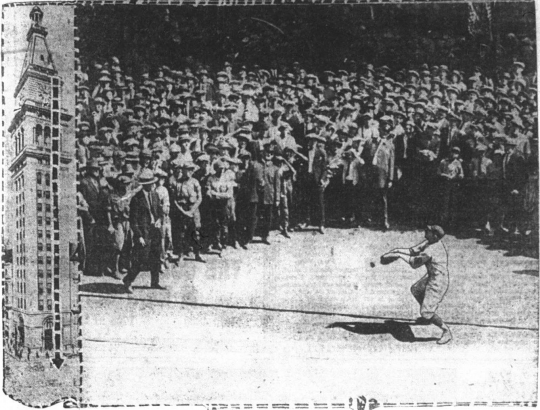On Saturday, August 26, 1922, Dixie Parker stood on the corner of 16th and Arapahoe in Downtown Denver and performed a feat of baseball prowess that is unlikely to ever be replicated. On that fateful day, Parker, who also happened to be a catcher for the Denver Bears, caught a baseball that was dropped from the top of the D&F Tower, a height of approximately 335 feet.
At the time, the D&F Tower was the tallest spot in Denver, and for hundreds of miles in any direction, so the event drew a crowd of thousands to Denver's Downtown to see if Parker could handle a big drop. And to make sure the ball was dropped by someone who knew what he was doing, Bears pitcher Herb Hall was given the honor of actually dropping the ball.
Hall's first effort at ball dropping just missed Parker's glove while the second toss was described by the Denver Post as, "wild," bounced off the ground and was caught by a Denver policeman. On the the third toss Parker caught the ball just before it hit the ground, but the force of the falling ball nearly knocked him to the ground, too.
As one might imagine, a baseball falling from 335 feet travels pretty fast. We're not great at math and physics, but the folks over at the Hardball Times can help bring us closer. According to their calculations, Babe Ruth once caught a baseball dropped from a blimp that was hovering at 300 feet and that ball was traveling at 75 miles per hour. So we're guessing that the ball dropped from the D&F Tower was going at least that fast.
In case anyone was wondering about the trajectory of the ball, the Denver Post helpfully published a chart that maps the ball's, highly predictable, drop from the tower.
What inspired Parker to attempt such a feat? It should come as no surprise to find out the whole thing was part of a bet Parker made with Bears' outfielder Tommy Long. There's no word on what the winner took home but Parker's luck did change, a bit, after the catch. In 1923 he got called up to the big leagues where he spent a single season with the Philadelphia Phillies and appeared in four games. After that, Parker bounced around the minor leagues until he retired from the game in 1941. He died in Tuscaloosa, Alabama, in 1972 at the age of 77.
As far as we know, no Denver baseball player has ever recreated Parker's epic catch.


Comments
Fascinating, Brian!
Fascinating, Brian!
Thanks Stephen - We've
Thanks Stephen - We've calculated that the ball was likely traveling more than 100 mph when it hit the glove. He's lucky he didn't break his hand!
The Hardball Times link you
The Hardball Times link you give suggests somewhere a bit over 75, but less than 89 mph for a 335 foot drop. In other words, in the same range as MLB catchers regularly see on offspeed pitches. And it gives a terminal velocity of less than 100 mph, no matter how many hundreds of feet you drop the baseball.
This is great! I love the WOW
This is great! I love the WOW Wednesdays. Thanks for the research.
Thank you! We have a great
Thank you! We have a great time researching them and are grateful to the library researchers who suggested this one!
The Splat Calculator at https
The Splat Calculator at https://www.angio.net/personal/climb/speed.html is where the 100 mph figure was derived.
Neither one is going to break the hand of whoever tries to catch it. Perhaps we can get a Colorado Rockies player to try it now and get a few speed guns on it since they too seem to have variations on each pitch.
Add new comment